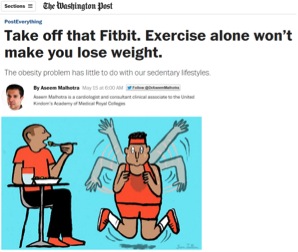Whether listening to the radio or reading the newspaper in the last few weeks, it’s likely that you noticed the BJSM gaining a fair amount of media coverage. The attention has centred on the issue of diet & weight loss (not surprisingly, fuelling a more spirited debate than the average hamstring injury article!), specifically, an editorial by Dr Aseem Malhotra, which suggests that physical activity without consideration of diet, is insufficient in the fight against obesity.

Some media outlets portrayed the article as driving a nail into the coffin of physical activity as a preventative health modality, failing to mention that the editorial argued strongly that a minimum of 30 minutes of physical activity a day provides a great return-on-investment for all-round health. @DrAseemMalhotra simply questioned the evidence-base regarding the effectiveness of physical activity alone in reducing obesity, an independent health issue in its own right. He also provides a call-to-action to “bust the myth of physical inactivity and obesity,” namely the misconception that if you exercise you can eat whatever you want with no health concern.
That article was preceded by a perspective from the University of South Carolina and ACSM’s esteemed Professor Steven Blair, a BJSM Senior Associate Editor. He and two colleagues point out the imbalance in energy balance research, and call for further investigation into the concept of ‘energy flux’ in causing obesity; the Global Energy Balance Network is already undertaking some of this work.
Professor Blair directy rebutted to the Malhotra editorial as a blog on the Global Energy Balance Network website and shared this via his wide reach on Twitter (@StevenNBlair). That blog is about to be accepted as an editorial in BJSM and it, and another relevant editorial will be in BJSM issue #15 (July) – curated by the South African Sports Medicine Association.
So what actually works?
Whilst obesity levels expand and expand, discussion around the optimal diet to reverse this trend include the practice of reducing carbohydrates and increasing fat intake. The optimal extent of these changes are also the topic of intense debate. BJSM published an editorial by Professors Noakes and Phinney on the argument for a low carbohydrate, high fat diet #LCHF. Dr Peter Brukner, (@PeterBrukner) a self-avowed #LCHF convert, interviewed Professor Noakes on this BJSM podcast. Importantly, BJSM has commissioned a counterpoint from leaders in sports nutrition and performance.
If you are open to challenging ideas, here are links to the #LCHF summit conference highlights1,2,3, whilst you can also enjoy Dr Malhotra’s provocative podcast on #DontFearTheFat and the more recent one clarifying his editorial.
Whether you’re a #LCHF advocate or have never heard of it before, one of the most impressive educational resources that discusses the issue is a TEDx video by Dr Sarah Hallberg – Medical Director of the Medically Supervised Weight Loss Program at IU Health Arnett. She provides insight into the cultural interests that led to the normalization of high carb low fat diets, and proliferated the diabetes and obesity epidemic. She also explains practical, diet based, strategies to combat these diseases. So if you want to learn more about why you shouldn’t fear the fat, sit back (or stand…) and enjoy.
Whilst cutting carbohydrates has historically been associated with celebrity diets, the mounting evidence is hard to ignore, as is this diet’s establishment as a sustainable and effective way to fight obesity. If you need further convincing (or haven’t the time to watch the clip), why not listen to Dr Jason Fung discuss the issues of insulin and diet in relation to type 2 diabetes and obesity. Enjoy these resources and join the conversation on our social media platforms (Twitter, Facebook & Google+).
Blog References
https://blogs.bmj.com/bjsm/2015/03/12/part-1-to-lchf-or-not-to-lchf-thats-the-dietary-question/
https://blogs.bmj.com/bjsm/2015/03/15/part-2-to-lchf-or-not-to-lchf-thats-the-dietary-question/